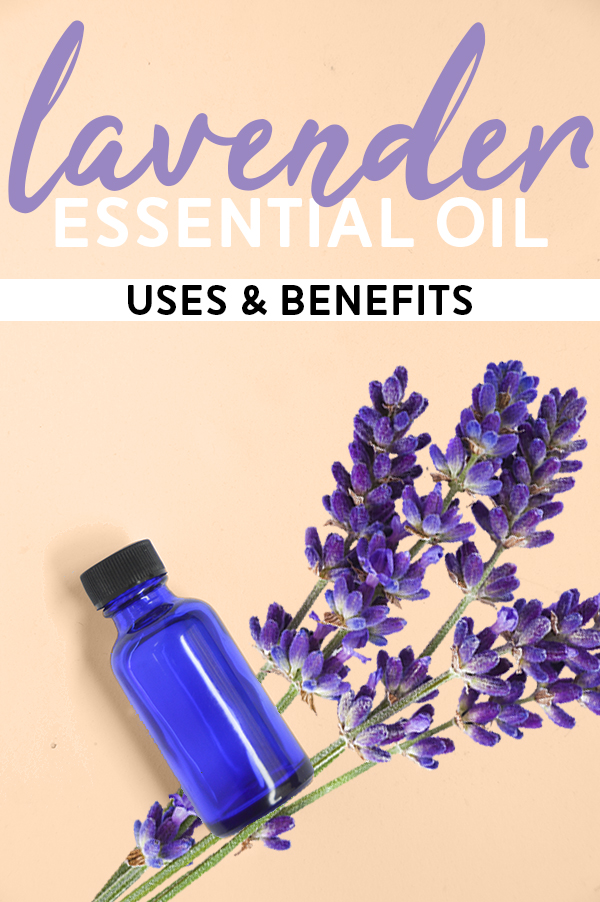
If you’re new to essential oils, it can be overwhelming. Where to start? Which essential oils should you purchase first? How should you use them? As I begin to profile specific oils, I’m going to start with the ones that are most common, safest to use, versatile and affordable. And when it comes to fitting all those criteria, there’s really only one place to start: Lavender. We’re going to take a deep dive in and talk about all the uses for and benefits of Lavender essential oil.
It’s worth noting that when building an essential oil collection, the ones that are most useful will depend on your individual goals, current mental/emotional/spiritual/physical ailments, personal preference and personality. I’d argue Lavender has a place in any essential oil cabinet, but as you read though its benefits, you should make that call for yourself.
I’ll share a couple specific recipes for using Lavender essential oil below, but I’m saving thorough explanations of other blends for future posts. I plan to dedicate posts to specific areas of health (essential oils for anxiety, for sleeping better at night, for focusing on work, for acne, etc.)—and that’s where I’ll really break down specific blends you can make at home.
As I mentioned in last week’s post on essential oil safety, if you have a history of sensitive skin and/or allergic reactions, do a skin patch test with Lavender before using it in any blend. It’s super safe, but can’t hurt to check! Details on performing a skin patch test are in that linked post.
The links in this post will be to Plant Therapy essential oils (they are affiliate), a brand I personally use and trust. I encourage you to do your own research though (Mountain Rose Herbs and Aura Cacia are two other brands I love). This post goes over what to look for in choosing an essential oil brand, should you be interested.
Uses for and Benefits of Lavender Essential Oil
Lavender is like the duct tape of essential oils: It’s the solution for everything. That’s an exaggeration, of course, but it really does add value to just about any blend. This is because Lavender is something called a “potentiator.” Potentiators increase the effect of a drug/substance (or in this case, essential oil blend). Lavender blends well with almost any other oil to supporting healing, balancing and anti-inflammatory properties.
Further making it a great first purchase, Lavender is safe to use with very few contraindications. You should avoid it if you have extremely low blood pressure, but other than that it’s generally safe for regular use, is nontoxic, non-irritating and non-sensitizing.
You do, however, want to make sure you’re using the right type of Lavender. True Lavender, which is the one most commonly available and the one I’m recommending in this post, will have the Latin botanical name Lavendula officinalis, Lavendula angustifolia, or Lavendula vera on the bottle label. If the bottle says Lavender spica then that’s Spike Lavender. Still a useful oil, but it’s chemical composition is different, so it’ll have different uses and safety precautions.
Stress/Anxiety Relief
Lavender is a nervine (calming to the nervous system) and relaxing. Diffusing it throughout the room and/or adding to a bath can help alleviate feelings of stress and anxiety. If you’re on the go and feeling anxious/stressed, try putting a couple drops of Lavender on a tissue and holding up to your face, taking deep inhales and exhales with your eyes closed. I like to do this, counting to 10 full breaths. It may sound silly, but taking a moment to pause and focus on breath with the addition of aromatherapy does wonders. In this way, Lavender is also hypotensive, decreasing blood pressure via relaxation.
Aids in Falling & Staying Asleep
This is one of the signature benefits of Lavender essential oil. As a sedative nervine, Lavender can help promote sleep. There are other essential oils that work as beneficial sleep aids as well, but if your insomnia is due to stress and/or anxiety, Lavender should be your first pick.
Joe used to have a lot of trouble falling asleep, mostly due to work-related stress/anxiety, so I diffuse the following blend at night.
- 6 drops Lavender
- 3 drops Sweet marjoram
- 1 drop Ylang-ylang
As discussed, Lavender can act as a sedative and calm stress and anxiety. Sweet marjoram is another essential oil that’s useful as a sleep aid, acting as a sedative and calming hyperactivity. Ylang-ylang is also a sedative and helps with stress and anxiety, plus I just love the way it smells and think it blends nicely with the other two scents.
I add these drops to my diffuser and put it in the living room on the intermittent setting about an hour before bed as we’re winding down and it really has helped Joe fall asleep at a reasonable hour! If your issue is staying asleep, I’d set up the diffuser in your bedroom instead.
Facial Skin Care
Pretty much regardless of your skin type, Lavender can be beneficial because it’s a correcting oil (also called an adaptogenic oil). This means it can both increase and decrease certain skin functions to normalize the skin based on individual need. So whether you have oily, dry, normal, sensitive, irritated and/or mature skin, Lavender can be beneficial.
General Skin Care
Lavender is great for any inflammation of the skin. It’s useful for eczema, psoriasis, acne and scars. Also for general swelling or bruising.
I was having this weird persistent itchiness on the outside of my left foot that would pop up randomly a few times a week and drive me insane so I made a blend the following blend to apply to the affected area.
- 4 drops Lavender
- 2 drops Tea tree
- In 1/2 oz of Sweet almond oil (but you can use any carrier oil—even high-quality olive oil!)
Lavender is antipruritic (relieves itching) and is also anti-fungal (I thought maybe the itching was due to a fungus overgrowth since I teach all day in sweaty socks and sneakers). Tea tree essential oil is also anti-fungal and anti-inflammatory.
At first I would massage into the side of my foot when the itching started, and SWEEET RELIEF. Then I started applying every evening, regardless of if it was itching or not to see if I could stop the episodes altogether. I did that for three weeks and it hasn’t been an issue since.
First Aid
Think wounds, cuts, bruises, bug bites, burns and sunburns. Lavender is one of the few essential oils that can be applied neat (without being diluted with a carrier) to the skin. For a bug bite, try putting a couple drops of Lavender on a cotton swab and gently pressing onto the area.
Headaches
Peppermint is the real star when it comes to headache relief (more on that below), but Lavender can be particularly helpful if the headache is caused by stress/anxiety. Try blending them together. As an added bonus, add them to a cold foot bath and soak so that blood is drawn from the head down to the feet (2 drops of each is a good amount for a small foot bath).
PMS Symptoms & Other Lady Thangs
Lavender is antispasmodic and relieving for muscle pain, making it great for soothing menstrual cramps. It also has estrogenic and hormone-balancing properties, making it great for that time of the month, and also during menopause. Lavender is an emmenagogue, meaning it can promote menstruation. Because of this, it’s used in treatments for amenorrhoea.
Lavender is also useful during pregnancy, especially with morning sickness. Peppermint is really the best when it comes to easing nausea, but it’s a stimulant and therefore you shouldn’t overdo using it while pregnant. Lavender is a great alternative.
Balancing
I’ve touched on this throughout the post in talking about Lavender at a potentiator and an adaptogenic oil: Whether using it for physical, emotional, mental or spiritual benefit, it promotes balance. We’ve mainly focused on Lavender’s action as a sedative, but it can really be a sedative or stimulant depending on a person’s needs and on the other oils with which it’s blended. I think of it as a calming, but uplifting oil.
_______________
If you have more questions about Lavender essential oil, drop them in the comments! And if you’re interested in getting a bottle, here are some quick links:
- Organic Lavender essential oil from Plant Therapy
- Same oil but via Amazon (Prime, baby!)
xo Nicole
And before I end this post, some important information that will be included at the end of all posts on aromatherapy I do. 🙂
The statements and blends referenced in this post have not been evaluated by the Food and Drug Administration. Products and/or information are not intended to diagnose, treat, cure or prevent any disease. If you are pregnant, nursing, have a medical condition or are taking any medication, consult with your physician before using any essential oil or blend.
I’m a Certified Holistic Aromatherapist through the Institute of Integrative Aromatherapy and only share blends with you that I’ve personally used and from which I’ve benefited. I stand behind them 100%! That being said, essential oil blends are most effective when made with the individual in mind. In the future, I’ll be offering individual consultation, formulating blends make specifically for your individual needs, goals and personality. Can’t wait to share more with you when that day comes!








Lavender is DEF my favorite essential oil, as a yoga teacher I love using it during savasana. I’ll also use it at the end of the day when I’m winding down.
Is lavendar safe to diffuse at home with a one-year-old and a cat?
*Lavender
Yes! Totally safe. If you were to apply it in a blend to a child’s skin, you’d want to dilute it (no more than .5-1% of the oil in a carrier), but you can diffuse it as normal. 🙂
I am loving these new essential oils posts!